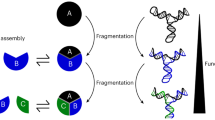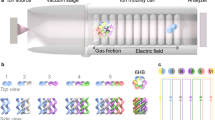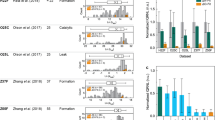Abstract
Here we describe a system that enables short peptides to bind DNA sequence-specifically. Linking the peptide covalently to DNA through a disulphide bond eliminates the unfavourable energetic cost of diffusion and thus potentiates the peptide-DNA interaction. By this approach we have deconstructed the GCN4/DNA complex into its elemental DNA recognition units. We find that the GCN4 basic region contacts the two half-sites with very different affinities and propose that this thermodynamic asymmetry plays a role in differential regulation of gene expression. Specific binding of the peptide to DNA stabilizes the disulphide bond toward reduction suggesting a novel approach to the discovery of new DNA-binding specificities.
This is a preview of subscription content, access via your institution
Access options
Subscribe to this journal
Receive 12 print issues and online access
$189.00 per year
only $15.75 per issue
Buy this article
- Purchase on Springer Link
- Instant access to full article PDF
Prices may be subject to local taxes which are calculated during checkout
Similar content being viewed by others
References
Pabo, C.O. & Sauer, R.T. Transcription factors: Structural families and principles of DNA recognition. A. Rev. Biochem. 61, 1053–1095 (1992).
Harrison, S.C. A structural taxonomy of DNA-binding domains. Nature 353, 715–719 (1991).
DeGrado, W.F., Wasserman, Z.R. & Lear, J.D. Protein design, a minimalist approach. Science 243, 622–628 (1989).
Steitz, T.A. Structural studies of protein-nucleic acid interaction: the sources of sequence-specific binding. Q. Rev. Biophys. 23, 205–280 (1990).
Spolar, R.S. & Record, M.T., Jr Coupling of local folding to site-specific binding of proteins to DNA. Science 263, 777–784 (1994).
Klemm, J.D., Rould, M.A., Aurora, R., Herr, W. & Pabo, C.O. Crystal structure of the Oct-1 POU domain bound to an octamer site: DNA recognition with tethered DNA-binding modules. Cell 77, 21–32 (1994).
Beamer, L.J. & Pabo, C.O. Refined 1.8 Å crystal structure of the λ repressor-operator complex. J. molec. Biol. 227, 177–196 (1992).
Wolberger, C., Vershon, A.K., Liu, B., Johnson, A.D. & Pabo, C.O. Crystal structure of a Matα2 homeodomain-operator complex suggests a general model for homeodomain-DNA interactions. Cell 67, 517–528 (1991).
Kissinger, C.R., Liu, B., Martin-Bianco, E., Kornberg, T.B. & Pabo, C.O. Crystal structure of an engrailed homeodomain-DNA complex at 2.8 A resolution: A framework for understanding homeodomain-DNA interactions. Cell 63, 579–590 (1990).
Somers, W.S. & Phillips, S.E.V. Crystal structure of the met repressor-operator complex at 2.8 Å resolution reveals DNA recognition by β-strands. Nature 359, 387–393 (1992).
Ellenberger, T.E., Brandl, C.J., Struhl, K. & Harrison, S.C. The GCN4 basic region leucine zipper binds DNA as a dimer of uninterrupted α helices: Crystal structure of the protein-DNA complex. Cell 71, 1223–1237 (1992).
Struhl, K. Promoters, activator proteins, and the mechanism of transcriptional initiation in yeast. Cell 49, 295–297 (1987).
Landschulz, W.H., Johnson, P.F. & McKnight, S.L. The leucine zipper: a hypothetical structure common to a new class of DNA binding proteins. Science 240, 1759–1764 (1988).
Alber, T. Structure of the leucine zipper. Curr. Opin. Genet. Develop. 2, 205–210 (1992).
König, P. & Richmond, T.J., X-ray structure of the GCN4-bZIP bound to ATF/CREB site DNA shows the complex depends on DNA flexibility. J. molec. Biol. 233, 139–154 (1993).
Talanian, R.V., McKnight, C.J. & Kim, P.S. Sequence-specific DNA binding by a short peptide dimer. Science 249, 769–778 (1990).
Talanian, R.V., McKnight, C.J., Rutkowski, R. & Kim, P.S. Minimum length of a sequence-specific DNA binding peptide. Biochemistry 31, 6871–6875 (1992).
Cuenoud, B. & Schepartz, A. Altered specificity of DNA-binding proteins with transition metal dimerization domains. Science 259, 510–513 (1993).
Park, C., Campbell, J.L. & Goddard, W.A., III Design superiority of palindromic DNA sites for site-specific recognition of proteins: Tests using protein stitchery. Proc. natn. Acad. Sci. U.S.A. 90, 4892–4895 (1993).
Suckow, M., Von Wilcken-Bergmann, B. & Müller-Hill, B. The DNA binding specificity of the basic region of the yeast transcriptional activator GCN4 can be changed by substitution of a single amino acid. Nucleic Acids Res. 21, 2081–2086 (1993).
O'Neil, K.I., Shuman, J.D. & DeGrado, W.F. DNA-induced increase in the α-helical content of C/EBP and GCN4. Biochemistry 30, 774–778 (1991).
Patel, L., Abate, L. & Curran, T. Altered protein conformation on DNA binding by Fos and Jun. Nature 347, 572–575 (1990).
Weiss, M.A., Ellenberger, I., Wobbe, C.R., Lee, J.P., Harrison, S.C. & Struhl, K. Folding transition in the DNA-binding domain of GCN4 on specific binding to DNA. Nature 347, 575–578 (1990).
Oliphant, A.R., Brandl, C.J. & Struhl, K. Defining the sequence specificity of DNA-binding proteins by selecting binding sites from random-sequence oligonucleotides: Analysis of yeast GCN4 protein. Molec. cell. Biol. 9, 2944–2949 (1989).
Sellers, J.W., Vincent, A.C. & Struhl, K. Mutations that define the optimal half-site for binding yeast GCN4 activator protein and identify an ATF/CREB-like repressor that recognizes similar DNA sites. Molec. cell. Biol. 10, 5077–5086 (1990).
Hill, D.E., Hope, I.A., Macke, J.P. & Struhl, K. Saturation mutagenesis of the yeast his3 regulatory site: Requirements for transcriptional induction and for binding by GCN4 activator protein. Nature 234, 451–457 (1986).
Ferentz, A.E. & Verdine, G.L. Disulfide cross-linked oligonucleotides. J. Am. chem. Soc. 113, 4000–4002 (1991).
Ferentz, A.E., Keating, T.A. & Verdine, G.L. Synthesis and characterization of disulfide cross-linked oligonucleotides. J. Am. chem. Soc. 115, 9006–9014 (1993).
Jeffrey, G.A. & Saenger, W. Hydrogen Bonding in Biological Structures. (Springer-Verlag, Berlin, Heidelberg; 1991).
Jorgensen, W.L. & Pranata, J. Importance of secondary interactions in triply hydrogen bonded complexes: Guanine-Cytosine vs. Uracil-2,6-Diaminopyridine. J. Am. chem. Soc. 112, 2008–2010 (1990).
Author information
Authors and Affiliations
Rights and permissions
About this article
Cite this article
Stanojevic, D., Verdine, G. Deconstruction of GCN4/GCRE into a monomeric peptide-DNA complex. Nat Struct Mol Biol 2, 450–457 (1995). https://doi.org/10.1038/nsb0695-450
Received:
Accepted:
Issue Date:
DOI: https://doi.org/10.1038/nsb0695-450



